| The
Main Entrance of RAF Lakenheath is guarded by an old F-100D Super Sabre. These days, the
skies over Lakenheath are Eagle domain. Pilots flying the Super Sabre used their skills,
knowledge and a lot of courage. Today F-15 pilots are working their way across the sky
using all kinds of modern equipment, making them almost digital pilots. A visit at the Grim Reapers
The 493rd Fighter Squadron is the only USAFE unit to fly the F-15C version, among them
some old inhabitants of the Netherlands when flying with the 32FS Wolfhounds. Nicknamed
the "Grim Reapers" the unit is responsible for air defence and air superiority.
It shares RAF Lakenheath in the UK with two other Eagle squadrons, but those fly F-15E
Strike Eagle. During the Balkan conflict, the 493rd scored four aerial victories. After
the Afghan war, the Grim Reapers gave air support to the airlift flights with C-17’s.
These transport planes flew humanitarian goods into this dangerous region.
Flightgear Online is shown around by
Captain "Dobbr" Wistrcill in the squadron bunker. He welcomes us in the world of
JHMCS, ANVIS and Combat Edge…..
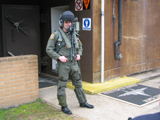 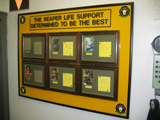
Left: Outside the squadron
bunker. Right: Reaper life support. Determined to be the best
JHMCS
The modern F-15C pilots wear the Joint Helmet Mounted Cueing System (JHMCS). JHMCS
combines a magnetic head tracker with a display projected onto the pilot's visor, giving
the pilot a targeting device that can be used to aim sensors and weapons wherever the
pilot is looking. With JHMCS, the pilot can aim the radar, air-to-air missiles, infrared
sensors, and air-to-ground weapons merely by pointing his/her head at the target and
pressing a switch on the flight controls. Additionally, the pilot can view any desired
data (airspeed, altitude, target range, etc.) while "heads-up", eliminating the
need to look into the cockpit during visual air combat.
The pilot can adjust the helmet's display to go blank when he's looking either at the HUD
or down into the cockpit. He can also programme it to go blank for both areas. The
helmet shells are made by Gentex and the electronics are made by VSI.
The oxygen mask is the MBU-20/P part of the
Combat Edge assembly. A mask supply hose is used that is similar to the standard silicone
rubber hose, but also incorporates the PBG helmet bladder supply hose and male
quick-disconnect connector which interfaces with the female connector attached to the
helmet. The helmet bladder has two functions; first it pulls the mask tighter to the face
while doing high G’s and therefore preventing oxygen leakage (pressure differences),
second is to stabilize the helmet on the pilots head.
Furthermore the helmet has a large data
cable that sends information from the airplanes system to the projection device in the
helmet. To prevent injuries on ejecting, the cable is secured to the pilots torso harness
with a clip.
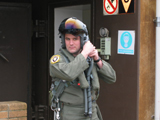 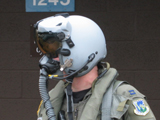 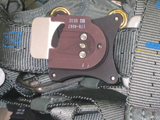
Left and centre: Pilot
showing the Joint Helmet Mounting Cueing System with integrated Combat
Edge bladder. Right: Thic clip on the pilot's torso harness is for
securing the JHMCS data cable.
ANVIS
Besides the JHMCS, the pilots use also the AN/AVS-9(V) (ANVIS Aviation Night Vision
Image System). These Night Vision Goggles, type F-9494G, binocular assembly consist of two
identical monoculars mounted under a pivot-and -adjustment shelf (PAS). The monoculars can
be moved in different ways to adjust them to the eyes. The monocular consist of three
subassemblies. One objective lens assembly, one monocular housing with image intensifier
and an eyepiece lens assembly. As the ANVIS can not be mounted to the JHMCS, the Grim
Reaper pilots have another helmet. This is the Gentex HGU-55/P (CE) another part of the
Combat Edge assembly. The binocular assembly is mounted to a banana shaped clip. This
clip, that houses also the batteries, is mounted to two metal brackets on the helmet.
This helmet is also used with the MBU-20/P
and has the bladder on the inside as described above. Another nice add on to this helmet
is the swivel oxygen mask receiver. This receiver is mounted to the side of the helmet
were the communications cord enters the helmet. With a simple click, the mask swings away
from the face.
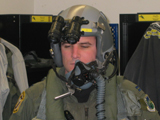 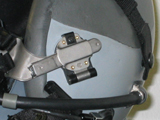 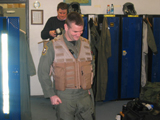
Left: AN/AVS-9(V) ANVIS
mounted on HGU-55/P(CE) helmet through the use of a banana shaped clip
attached to the helmet shell with two small metal brackets. Middle:
Swivel oxygen mask receiver that
allows the pilot to swing the mask away from his face. Right: Air Ace
vest ready for fitting different items
Combat Edge
Besides the already mentioned MBU-20/P mask, HGU-55/P (CE) or JHMCS helmet, the
ensemble consists of the CSU-13/P g-suit and the CSU-17/P pressure vest. The g-pants are
used to force the blood from the legs to the head while making high G’s. The vest
provides pressure on the chest when the breathing air is forced into the lungs (pressure
breathing).
Air Ace
Grim Reaper pilots wear the Air Ace vest (ACC version). This is a is a load-bearing,
multi-pocket, utility vest with a patented SnapTrack™ modular attachment system
that allows easy reconfiguration for different missions and changing circumstances. The
pilot can carry his side arm, radio and survival items on the positions useful to him.
Flightgear Online wishes to
thank the 493rd Fighter Squadron, and Super Tomcat for their help. All images are
copyright Dave Holden. |